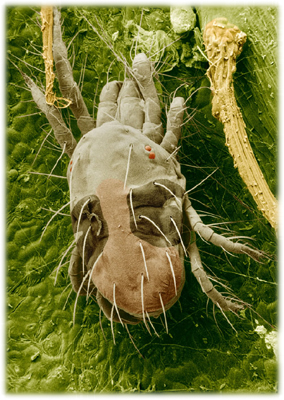 Spider Mites - July 18, 2007 Jeff Schalau, Associate Agent, Agriculture & Natural Resources, Arizona Cooperative Extension, Yavapai County Spider mites are arachnids, a group of arthropods which also includes spiders, ticks, and scorpions. Adult mites normally have eight legs and most have the ability to produce fine silk webbing. They have a two-segmented body and do not have antennae or wings. Spider mites are quite small and difficult to see with the unaided eye. Many species feed on plants. Plant-feeding spider mites can significantly weaken plants when environmental conditions are favorable. By contrast, there are also predatory mites that feed on plant-feeding mites as well as thrips and other small insects. Two-spotted spider mites are one of the most common plant-feeding spider mites found on crops and ornamental plants. A set of reddish to brownish spots on their back give the species its common name. The adults are very small, about 1/60 of an inch, and can be white, green, orange or red. The larva and nymph look similar to the adult but are smaller and may have only three sets of legs. Two-spotted spider mites are favored by hot dry weather which reduces the time required for a mite to complete its life cycle from egg to adult. Spider mite eggs are minute, spherical-shaped, bead-like objects that can be found on the underside of the leaf, usually near the leaf veins. Unlike many plant pests, two-spotted spider mites complete multiple generations during the growing season. Almost all of the individuals in the population are females. Each female produces about 300 offspring during her lifetime, which can last up to 30 days. Spider mites feed by puncturing plant tissue with piercing mouthparts. Chlorophyll is removed along with plant fluids. As a result, plants infested with spider mites have a white or yellow speckled appearance. Fine webbing may also be visible. The plants look dull and unthrifty. Mites feed primarily on the undersides of leaves, out of sight and away from direct sunlight. When mites feed on fruit, it causes bronzing or russetting. This discoloration makes the fruit cosmetically unappealing but seldom damages the edible interior of the fruit. Heavily infested plants may drop their leaves prematurely. If a spider mite infestation is suspected, hold a white piece of paper beneath the branch and tap the foliage sharply. Use a magnifying lens to inspect the paper for dislodged mites. They look like tiny, moving specks. This method also works well for diagnosing thrips. If possible, you can look closely to identify whether or not any predatory mites are present. This close inspection is crucial to making proper management decisions. If plant-feeding mites are not visible, natural enemies or environmental conditions may have already reduced their numbers. Predatory mites are about the same size as plant-feeding mites but have longer legs and are more active. Other insects that feed on spider mites are minute pirate bugs, bigeyed bugs, lacewings, and some ladybeetles. When predatory mites and insects are present, pesticides should not be used because it will have a negative effect on the predators. Dusty conditions favor plant-feeding spider mite outbreaks. Conifers are especially susceptible under dusty conditions. If feasible, you may apply water to pathways and other dusty areas at regular intervals. Water-stressed trees and plants are less tolerant of spider mite damage. Be sure to provide adequate irrigation. Mid-season washing of trees and vines with water to remove dust may help prevent serious late-season mite infestations. In gardens and on small fruit trees, regular, forceful spraying of plants with water will often reduce spider mite numbers adequately. Be sure to get good coverage, especially on the undersides of leaves. If more control is required, consider using an insecticidal soap or oil in your spray. Some miticides are available, but their use should be minimized to conserve populations of predatory mites and insects and to minimize pesticide resistance. The University of Arizona Cooperative Extension has publications and information on gardening and pest control. If you have other gardening questions, call the Master Gardener line in the Cottonwood office at 646-9113 ext. 14 or E-mail us at cottonwoodmg@yahoo.com and be sure to include your address and phone number. Find past Backyard Gardener columns or submit column ideas at the Backyard Gardener web site: http://cals.arizona.edu/yavapai/anr/hort/byg/. |